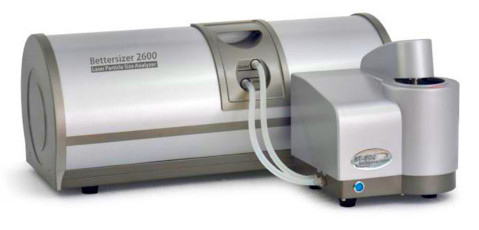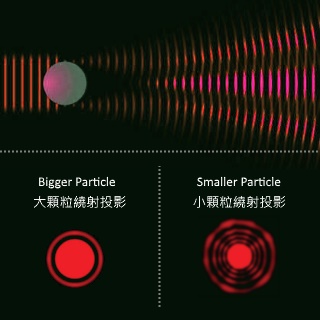Particle Size Analyzer Selection & Principles of Methods
Particle size analysis is an indispensable step in material analysis and material quality control. The size of the particles of specific material, significantly affect the stability, appearance, fluidity, and chemical reaction characteristics of the material.

Types of Particle Size Analyzer
The particle size analyzer is a special instrument which is used to measure the particle size. There are a variety of particle size analyzers in the market which are based on different measurement technologies. These basic technical methods can be fitted into different materials and different applications. Therefore, selecting a proper particle anzlyer, and fit to the size range of particles and applications, is a very important important prerequisite for material research.
The following list gives you the most common measurement techniques from different basic principles. Each particle size measurement technique has its best size range and which is applicable to the specific applications.
Particle size analysis method and applicable particle size:
| 0.1nm | 1nm | 10nm | 100nm | 1um | 10um | 100um | 1mm | 10mm | |||
| Morphological Imaging 1um - 3mm |
|||||||||||
| Spatial Filter Velocimetry 50um - 5mm |
|||||||||||
| ★Laser Diffraction 10nm - 3.5mm |
|||||||||||
| Resonant Mass Measurement Resonant Mass Measurement 50nm - 5um |
|||||||||||
| Nanoparticle Tracking Analysis 30nm - 1um |
|||||||||||
| Dynamic Light Scattering 1nm - 1um |
|||||||||||
| Taylor Dispersion Analysis 0.2nm - 20nm |
Among these particle measurement methods, the most common one with the widest size range is the laser diffraction method. A laser diffraction particle size analizer covers the particle size of the materials above 10 nm. Users would most likely select a laser diffraction particle size analyzer for most of the applications. According to the characteristics of the materials, the particle size analyzer can be divided into wet measurement and dry measurement. Besides, most high-level laser particle size analyzers is usually assisted by the “Morphological Imaging” method, and lead the measurement results closer to the actual conditions. The appearance of the particles can also be observed from high speed video camera, and the measurement results can be appropriately scaled.
For measurements of particles smaller than 10nm, one can consider the "Dynamic Light Scattering" or "Taylor Dispersion Analysis" method.
ACTTR Technology brought to you a series of full automatic particle size analyzers with great features and cost-effective solutions. If you would like to learn more details about these Laser Particle Size Analyzers, please visit ACTTR Technology Particle Size Analyzer product page, or contact ACTTR Technology, we will sincerely serve you!
Morphological Imaging
By a high-speed video cameras to capture the appearance of particles, and measures the length, width, appearance, roundness, and crown of the particles. And then combines evaluations by calculating equivalent spherical statistics, which are closer to actual conditions. At the same time, the particle images captured by high-speed cameras can also be used to further understand the grain thickness of the particles. Besides, either the surface is bright or dark, by this method, one can observe the texture of the surface of particles.
Spatial Filter Velocimetry
The particles are passed vertically through the transverse laser beam, and then a linear fiber array photodetector is placed at the axial end of the laser beam. The sensor is used to sense the shadow movement of the particles. By the principle of a spatial filter, the moving speed of the particles is obtained. In addition, by applying a fixed-frequency pulse signal mixing measurement, the particle movement time can be measured at the same time. With a measurable movement speed and elapsed time, the particle's chord length (particle length along the direction of travel) can be estimated, and results the particle size.
★Laser Diffraction
This is a method for counting the average particle size of a group of particles from a macroscopic point of view, rather than actually measuring the size of a single particle. According to the Mie Scattering principle, different diffraction results are generated when laser light is irradiated on particles of each sizes. When the radius of the particle is closer, or greater than the wavelength of the laser, most of the light travels in the direction of laser will be diffracted. And the pattern of the laser spot gets more focused. Conversely, when particles with relatively small sizes are irradiated, the laser spot pattern looks more diffuse and fuzzy.

Projection of Laser Diffraction Spot on Bigger and Smaller Particle
Dozens of photodetectors are used in the Laser Particle Size Analyzer to cover the angular range around 170 degrees of the scattered light of the laser. And a image sensor is used to measure the angle and intensity of the scattered light, and even the pattern. Finally, convert the data to a particle size distribution map. According to the specifications of ISO 13320, D10, D50, and D90, are the percentages of divisions, and it is used for describing a group of particles. At present, the laser diffraction method is the most widely used in particle size analysis. ACTTR Technology offers a variety of laser particle size analyzers suggested for your selection.
Resonant Mass Measurement
The same concept of an atomic force microscope, the resonance mass method is also using a micro-machined sensor (MEMS), but replace the probe needle on the cantilever with a microfluidics. When particles of different sizes pass through the microfluidics, they will generate buoyancy force on the cantilever, generate a resonant frequency signal from the cantilever. Measure the resonant frequency of the cantilever through the laser beam, and the mass of the particle can be obtained and one can convert it into size of particle. The advantage of this method is that particles with positive or negative charge can be measured, and the materials like protein aggregates in biological agents can be distinguished.
Nanoparticle Tracking Analysis
This is a method based on microscopic video imaging technology that uses laser light as the light source and uses a high-speed camera to track the displacement of one single particle in the field of view. According to Stokes-Einstein Kinetic Theory, small particles move faster than large particles. From the microparticle's mobility and the viscosity of the medium, we can apply the values into Stock-Einstein equation and the radius of the particle is obtained. This method is commonly used in biomedical particle size measurement.
Dynamic Light Scattering
This method is also based on the same Stokes-Einstein Kinetic Theory. The particles in the solution will not be still, but continuously acts as Brownian Motion. The scattered light irradiated by the laser beam on the particles is detected by a photo sensor. And the diffusion coefficient of the particles can be obtained by measuring the intensity of scattered light. Then, apply the measured values into Stokes-Einstein equation, the radius of the particle can be calculated.
Dynamic Light Scattering method is commonly used in the measurement of nano particles which are smaller than 1 μm. The most modern dynamic light scattering technology can even be able to measure nano particles smaller than 10 nm.
Taylor Dispersion Analysis
In this method, the microparticle sample solution is injected into the microcapillaries. The sample will move along the capillary this way. At the end of the capillary, the cross-section of the capillary is measured continuously by a UV spectrophotometer. The UV light absorbance of the sample that passes through the cross section can be measured by a fixed frequency, and finally a absorption vs. time graph can be obtained, which is known known as "Taylorgram". This graph presents a bell curve, which represents the change of concentration of particles through the cross-section. Analyze the width of the curve in the "Taylorgram" can get the diffusion coefficient of the kinetic theory. Finally, the particle radius can be obtained by the equation of Stokes-Einstein. Taylor Dispersion Analysis can detect the smallest particle size which is smaller than 1 nm particles. This method is currently used in biomedical particle sizer, such as excipients and drug carrier.
To learn more about the superior performance of the best Particle Size Analyzer, you are welcome to Contact ACTTR Technology, we will have dedicated personnel to serve you and provide consultation!
#Bttersize Particle Size Analyzer


